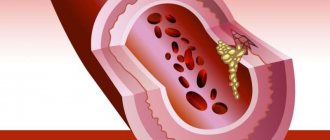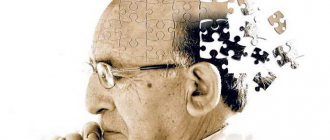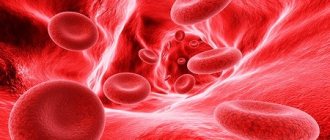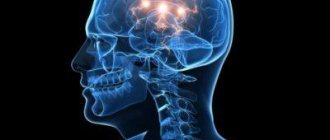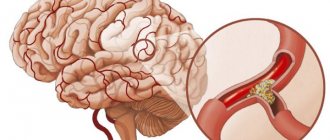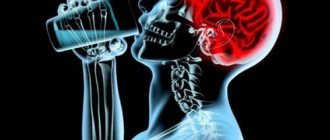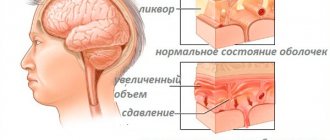Viral, autoimmune and vascular diseases of the brain are often accompanied by destruction of nerve fibers and loss of the most important functions of the organ. Thus, progressive leukoencephalopathy is characterized by damage to the membranes of neuronal processes and gradual degeneration of the central nervous system. This is a rare pathology that occurs in patients with reduced immunity.
There are other mechanisms of damage to the nervous system. Vascular encephalopathy is highly treatable, but if a viral infection of the central nervous system is detected, the prognosis is poor.
Causes
It is customary to distinguish 3 main causes leading to leukonencephalopathy. These are hypoxia, persistently high blood pressure and viruses. The following diseases and conditions provoke its occurrence:
- endocrine disorders;
- hypertension;
- atherosclerosis;
- malignant tumors;
- tuberculosis;
- HIV and AIDS;
- spine pathologies;
- genetic factor;
- bad habits;
- birth injury;
- taking medications that reduce the body's immune response.
The provoking effect of harmful factors leads to demyelination of nerve fiber bundles. The white matter decreases in volume, softens, and changes structure. Hemorrhages, lesions, and cysts appear in it.
Demyelination is often caused by polyomaviruses. In an inactive state, they are constantly present in human life, remaining in the kidneys, bone marrow, and spleen. Weakened immunity leads to the activation of viruses. White blood cells carry them to the central nervous system, where they find a favorable environment in the brain, settle in it and destroy it.
Usually only the white matter undergoes irreversible changes. However, there is evidence that, probably, the periventricular type of leukoencephalopathy also leads to damage to the gray matter.
How long do people live with leukoencephalopathy - prognosis
It is currently impossible to recover from leukoncephalopathy of vascular origin. The goal of drug treatment is to maintain the patient’s quality of life and prolong it. The prognosis is not favorable; only 40% of patients diagnosed will survive more than 6 months from the time of diagnosis.
Results can be achieved by resorting to antiretoviral therapy when lesions of the brain structure are first detected. In this case, the life expectancy of the victim will increase to 1-2 years. It is not possible to avoid the symptoms of dementia.
Attention ! In the acute course of the disease against the background of the progressive development of a retrovirus, the patient’s life expectancy is no more than 1 month.
Death is inevitable; it is the result of leukoencephalopathy of any type.
Classification
Determining the main cause of the pathology and the nature of its course allows us to distinguish several types of leukoencephalopathy.
Discirculatory
The main reason for the appearance and development of small focal leukoencephalopathy of vascular origin is damage to the blood vessels of the brain caused by hypertension, trauma, the appearance of atherosclerotic plaques, endocrine diseases, and spinal diseases. Blood circulation is impaired due to blood thickening and blockage of blood vessels. Alcoholism and obesity are factors that worsen the condition. It is believed that the disease develops in the presence of aggravating hereditary factors.
This pathology is also called progressive vascular leukoencephalopathy. First, small lesions of vascular lesions appear, then they increase in size, causing a deterioration in the patient’s condition. Over time, signs of pathology, noticeable to others, increase. Memory deteriorates, intelligence decreases, and psycho-emotional disorders arise.
The patient complains of nausea, headache, and constant fatigue. Vascular small focal encephalopathy is characterized by pressure surges. The person cannot swallow and has difficulty chewing food. Tremor appears, which is characteristic of Parkinson's disease. The ability to control the processes of urination and defecation is lost.
Focal encephalopathy of vascular origin is recorded mainly in men after 55 years of age. Previously, this violation was included in the ICD list, but later it was excluded.
Progressive multifocal
The main feature of this type of disorder is the appearance of a large number of lesions. The inflammation is caused by human polyomavirus 2 (JC polyomavirus). It is found in 80% of the world's inhabitants. In a latent state, it lives in the body for several years, but when the immune system is weakened, it is activated and, entering the central nervous system, causes inflammation.
Factors provoking the disease are AIDS, HIV infection, long-term use of immunosuppressants and drugs intended for the treatment of cancer. Progressive multifocal encephalopathy is diagnosed in half of patients with AIDS and 5% of people with HIV infection.
The lesion is often asymmetrical. Signs of PML include paralysis, paresis, muscle rigidity, and tremors reminiscent of Parkinson's disease. The face takes on the appearance of a mask. Possible loss of vision. Severe cognitive impairment and decreased attention appear.
Multifocal leukoencephalopathy has no cure. To improve the patient's condition, drugs that suppress the immune system are removed. If the disease is caused by an organ transplant, it must be removed.
Periventricular
Leukopathy of the brain in a child is caused by hypoxia that occurs during childbirth. Instrumental diagnostic methods make it possible to see areas of tissue death, mainly near the cerebral ventricles. Periventricular fibers are responsible for motor activity, and their damage leads to cerebral palsy. Lesions occur symmetrically and, in particularly severe cases, are found in all central areas of the brain. The defeat is characterized by the passage of 3 stages:
- emergence;
- development leading to structural changes;
- formation of a cyst or scar.
Periventricular leukoencephalopathy is characterized by 3 degrees of the disease. Mild degree is characterized by insignificant severity of symptoms. They usually go away within a week after birth. Moderate degrees are characterized by increased intracranial pressure and convulsions. In severe cases, the child is in a coma.
Symptoms do not appear immediately, some of them can be noticed only 6 months after the birth of the child. Most often, paresis and paralysis attract attention. Strabismus, lethargy, and hyperactivity are observed.
Treatment includes massage, physiotherapy, and special sets of exercises.
Leukoencephalopathy with vanishing white matter
The main cause of this disease is gene mutations that suppress protein synthesis. Most often it appears in children, mainly between the ages of two and six years. Provoking factors include severe mental stress caused by injury or serious illness.
Initial symptoms
At the initial stage of its appearance, leukoencephalopathy of the brain has a hidden course. The person may appear to others as more distracted, awkward, or self-absorbed.
In some cases, people experience increased tearfulness and irritability. They have problems with sleep - both falling asleep and intermittency of night rest. Additionally, muscle tone increases, which is manifested by convulsive twitching of individual muscle subgroups and eye movements. Speech difficulties arise - pronunciation and clarity of sounds suffer. Even short sentences and fame require some effort.
Intellectual activity gradually deteriorates - the patient can still perform his usual work duties, but if it is necessary to learn new material, he has difficulties. Dementia at the initial stage is manifested by forgetfulness, as leukoencephalopathy progresses it will become more and more noticeable - the person loses his ability to work.
Symptoms
The disease develops quite quickly in most cases. First, attention is drawn to absent-mindedness, emotional lability, indifference, a tendency to depression, and the appearance of phobias. The patient loses the ability to pronounce words, concentrate and switch attention, quickly gets tired, cannot even analyze ordinary events of the day, and forgets the names of relatives.
A progressive disease leads to sleep disturbances, irritability, increased muscle tone, and involuntary movements of the head and eyes. The patient's gait is disturbed.
At the next stage, there is a violation of movements, swallowing, a slowdown in the performance of all actions, paralysis, loss of sensitivity, numbness, tremors, and epileptic seizures. Cognitive abilities deteriorate and dementia develops. Possible loss of speech. A sharp deterioration in vision can lead to blindness. Often people suffer from urinary and fecal incontinence.
Diagnostics
Consultation with a neurologist and infectious disease specialist is necessary at the slightest suspicion of encephalopathy of any origin.
Electroencephalography is mandatory - it allows you to determine the electrical activity of the brain and detect signs and foci of convulsive activity. Magnetic resonance imaging will provide accurate information about the vessels, the location of lesions, their number, and characteristics. Almost all patients are prescribed a biopsy - a sample of brain tissue is taken. The bioassay is used in PCR and allows detection of the virus. Lumbar puncture allows detection of protein in the cerebrospinal fluid.
As one of the diagnostic measures, a consultation with a psychiatrist is carried out. He clarifies the patient’s mental disorders using neuropsychological testing.
Laboratory tests include a general blood test and a test for narcotic and toxic substances.
Treatment
To date, there is no remedy to prevent the destruction of white matter in the central nervous system. The main reason is the inability to influence inflammation. Medicines do not penetrate the blood-brain barrier (the natural barrier between brain tissue and blood).
The prescribed therapy is comprehensive and supportive. Its goals are to slow down the rate of development of the disease, normalize the psycho-emotional state of a person, and relieve symptoms:
- Medicines that stimulate and normalize blood circulation - Actovegin, Cavinton.
- Nootropic drugs - Nootropil, Pantogam, Cerebrolysin, Piracetam.
- Drugs intended to protect blood vessels - Curantil, Cinnarizine, Plavix.
- Virus protection products – Acyclovir, Kipferon, Cycloferon.
- Medicines containing steroid hormones - Dexamethasone.
- Drugs that improve blood clotting - Heparin, Fragmin.
- Antidepressants - Fluval, Prozac, Flunisan.
- Vitamin complexes with vitamins A, B, E.
- Preparations that can increase the body's resistance to the harmful effects of the environment - aloe extract, ginseng preparations.
Treatment includes homeopathic medicines, herbal medicines. Additionally, massage is performed, mainly of the collar area, physiotherapeutic methods, reflexology, and acupuncture.
Therapy
Treatment of encephalopathy associated with damage to the white matter of the brain is aimed at eliminating the causes that caused it. Therapy includes taking medications and using non-drug methods.
To treat vascular diseases that cause encephalopathy, means are used aimed at restoring their normal functioning. They are designed to normalize blood flow in brain tissues and eliminate the permeability of vascular walls. If necessary, blood thinners are prescribed.
The use of nootropic drugs that stimulate brain activity is indicated. It is recommended to take vitamins and immunostimulating medications. Non-drug methods include:
- therapeutic exercises;
- massage;
- physiotherapy;
- acupuncture.
It is possible to work with speech therapists, psychologists, and chiropractors. It is possible to increase the patient's life expectancy, it depends on the intensity of therapy and the general health of the patient. But it is impossible to completely cure the pathology.
Forecast
Leukoencephalopathy has no cure. How long people who have been diagnosed with this pathology live depends on the characteristics of its course and compliance with medical prescriptions. Constant intake of prescribed medications, implementation of preventive measures, and physiotherapeutic treatment prolong the patient’s life up to one and a half years from the moment the first symptoms appear.
Without drug support, life expectancy is six months. Lack of timely and correct treatment of an acutely developing disease reduces the life prognosis to one month.
Preventive measures and prognosis
As a rule, patients with vascular leukoencephalopathy live no more than two years.
Also, there are no clearly developed rules for preventing pathology. However, it is possible to minimize the risk of pathological changes in the white matter:
- with constant monitoring of blood pressure;
- giving up bad habits (alcohol, smoking, drugs);
- normal physical activity;
- taking care of your immune system;
- adherence to the principles of healthy eating.
Timely diagnosis and treatment of vascular leukoencephalopathy will help prolong the patient’s life.
Prevention
Considering that leukoencephalopathy occurs due to high blood pressure and hypoxia, the main preventive measures are aimed at preventing the exacerbation of these factors. It is recommended to normalize weight, play sports, strengthen the immune system, avoid excessive physical and emotional stress, follow a daily routine, and use prescribed medications. To prevent infection with AIDS, casual sex should be avoided.
By reducing the risk of hypertension, diabetes, and HIV infection, a person will thereby reduce the likelihood of developing encephalopathy.
Modern medicine makes it possible to establish an accurate diagnosis and identify the causes of leukoencephalopathy, but it is not yet able to stop the development of this disease and prevent its occurrence. Most modern medications help to briefly alleviate the patient’s condition and relieve some symptoms. However, their use is justified, because they allow a person to live for several more years.
